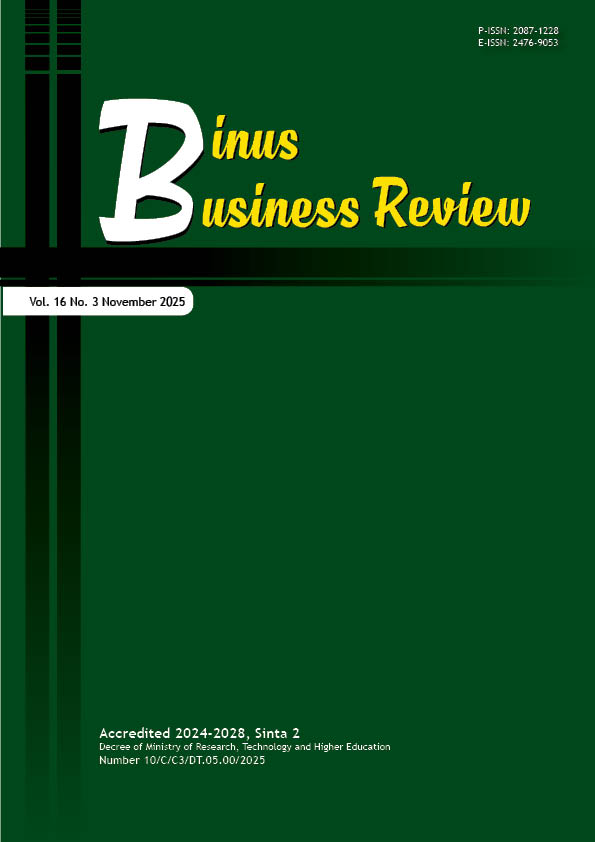Integrating Enterprise Risk Management (ERM) and Environmental, Social, and Governance (ESG) Risks into Balanced Scorecard (BSC) for Sustainable Performance in a Rural Bank
Keywords:
Enterprise Risk Management (ERM), Environmental, Social, and Governance (ESG), Balanced Scorecard (BSC), sustainable performanceAbstract
The research explored how integrating Enterprise Risk Management (ERM) based on ISO 31000 with Environmental, Social, and Governance (ESG) risk considerations into a Balanced Scorecard (BSC) framework could enhance sustainable financial performance in small financial institutions. A single-case study was conducted on Rural Bank, PT BPR “C”, while primary and secondary data were collected through questionnaires, interviews, and company documents. Risks were identified, analyzed, evaluated, and addressed in accordance with ISO 31000 principles, while ESG factors were embedded in the strategic mapping of BSC perspectives. The results reveal that environmental risks exert the most significant impact on financial outcomes, notably influencing key indicators such as Non-Performing Loan (NPL), Capital Adequacy Ratio (CAR), and Return on Assets (ROA). They highlight the urgent need for proactive risk mitigation strategies. By mapping risks to strategic objectives, the institution improves transparency, resilience, and alignment between risk management and performance measurement. The findings support extending the Resource-Based View (RBV) and Stakeholder theory, demonstrating that internal capabilities and stakeholder-focused governance can serve as critical drivers of competitive advantage and long-term value creation. The research offers practical contributions by presenting a replicable model for rural banks seeking to integrate ESG risk management into their operational and strategic frameworks. However, as a single-case study reliant on self-reported measures, the findings are limited in generalizability. Future research should explore longitudinal impacts and cross-institutional applications to validate and refine the integrated ERM-ESG-BSC framework proposed.
References
Abdalla, Y. A., Ibrahim, A. M., Lasyoud, A. A., & Warsame, M. H. (2022). Barriers of implementing the balanced scorecard: Evidence from the banking sector in the developing market. Journal of Governance & Regulation, 11(2), 173–180. https://doi.org/10.22495/jgrv11i2art15
Abueid, R., Rehman, S. U., & Nguyen, N. T. (2023). The impact of balanced scorecard in estimating the performance of banks in Palestine. EuroMed Journal of Business, 18(1), 34–45. https://doi.org/10.1108/EMJB-03-2021-0047
Adisti, D., Novianti, T., Kuswanti, H., & Suwarsinah. (2024). Environmental, Social, and Governance (ESG) risk management of PT XYZ Indonesia (ESG disclosure approach 2023). Business Review and Case Studies, 5(3), 498–509. https://doi.org/10.17358/brcs.5.3.498
Aevoae, G. M., Andries, A. M., Ongena, S., & Sprincean, N. (2023). ESG and systemic risk. Applied Economics, 55(27), 3085–3109.
Algeri, C., Brighi, P., & Venturelli, V. (2025). Integrating ESG factors into cost-efficiency frontier: Evidence From the European listed banks. Business Strategy and the Environment, 34(3), 3242–3270. https://doi.org/10.1002/bse.4140
Alsalami, T., Soo-Wah, L., Nor, S. M., & Alsheikh, A. H. (2023). The impact of enterprise risk management on financial performance: Evidence from the GCC Islamic banks. Asian Economic and Financial Review, 13(11), 818–831. https://doi.org/10.55493/5002.v13i11.4867
Ananta, M. A., & Anwar, M. (2025). Does ESG affect credit risk? Syntax Literate, 10(1), 445–462. https://doi.org/10.36418/syntax-literate.v10i1.17211
Ayele, N. F., & Singh, M. (2024). Beyond financials: Examining the impact of customer focus, internal processes, and learning & growth on the sustainable performance of commercial banks—Moderating role of management commitment. Business Strategy & Development, 7(4). https://doi.org/10.1002/bsd2.70030
Baek, S., & Kang, M. (2025). Does ESG enhance asset quality and funding cost management in banking diversification? Finance Research Letters, 73. https://doi.org/10.1016/j.frl.2024.106542
Bai, X., Han, J., Ma, Y., & Zhang, W. (2022). ESG performance, institutional investors’ preference and financing constraints: Empirical evidence from China. Borsa Istanbul Review 22(Suplement 2), S157–S168. https://doi.org/10.1016/j.bir.2022.11.013
Barney, J. (1991). Firm resources and sustained competitive advantage. Journal of Management, 17(1), 99–120. https://doi.org/10.1177/014920639101700108
Bhandari, K. R., Ranta, M., & Salo, J. (2022). The resource-based view, stakeholder capitalism, ESG, and sustainable competitive advantage: The firm's embeddedness into ecology, society, and governance. Business Strategy and the Environment, 31(4), 1525–1537. https://doi.org/10.1002/bse.2967
Bolibok, P. (2021). The impact of social responsibility performance on the value relevance of financial data in the banking sector: Evidence from Poland. Sustainability, 13(21), 1–19. https://doi.org/10.3390/su132112006
Bolibok, P. M. (2024). Does firm size matter for ESG risk? Cross-sectional evidence from the banking industry. Sustainability, 16(2), 1–26. https://doi.org/10.3390/su16020679
Breitenstein, M., Nguyen, D. K., & Walther, T. (2021). Environmental hazards and risk management in the financial sector: A systematic literature review. Journal of Economic Surveys, 35(2), 512–538. https://doi.org/10.1111/joes.12411
Brik, H. (2024). Climate risk and financial stability: Assessing non-performing loans in Chinese banks. Journal of Risk Management in Financial Institutions, 17(3), 303–315. https://doi.org/10.69554/XMFL8213
Bshayreh, M. M., Qawqzeh, H. K., Al-Momany, A. A., Saleh, M. M. A., & Al Qallap, K. D. H. (2024). The influence of balanced scorecard perspectives on the firms’ performance: Evidence from the banks in the developing market. Corporate & Business Strategy Review, 5(2), 243–254. https://doi.org/10.22495/cbsrv5i2art21
Capodagli, S., Ramrattan, D., & McCaskie, A. (2025). Conceptual framework for integrating ESG principles and risk management: enhancing Caribbean resilience and sustainability. World Journal of Entrepreneurship, Management and Sustainable Development, 21(1), 47–61. https://doi.org/10.47556/J.WJEMSD.21.1.2025.3
Carter, D. (2024). Case study as a research methodology. In Power, politics, and the playground: Perspectives on power and authority in education. Routledge
Chairani, & Siregar, S. V. (2021). The effect of enterprise risk management on financial performance and firm value: The role of environmental, social and governance performance. Meditari Accountancy Research, 29(3), 647–670. https://doi.org/10.1108/MEDAR-09-2019-0549
Chen, Y. S., Chiu, S. C., Lin, S., & Wu, K. H. (2019). Corporate social responsibility and income smoothing: Supply chain perspectives. Journal of Business Research, 97, 76–93. https://doi.org/10.1016/j.jbusres.2018.12.052
Defung, F., Yudaruddin, R., Ambarita, N. P., Che-Yahya, N., & Bahrudin, N. Z. (2024). The impact of ESG risks on bank stability in Indonesia. Banks and Bank Systems, 19(4), 194–204. https://doi.org/10.21511/bbs.19(4).2024.15
Del Sarto, N. (2025). Corporate governance and ESG controversies: Navigating risk-taking in banks. Business Strategy and the Environment, 34(4), 4541–4560. https://doi.org/10.1002/bse.4214
Denia, A. P., Sukmadilaga, C., & Ghani, E. K. (2024). Do enterprise risk management practices and ESG performance influence firm value of banks? Evidence from ASEAN countries. Asian Journal of Economic Modelling, 12(1), 35–52. https://doi.org/10.55493/5009.v12i1.4985
Dong, X., Son, S., & Roh, T. (2025). Strategic linkages to ESG performance: The role of performance measurement system and psychological empowerment. Business Strategy and the Environment, 34(4), 4372–4391. https://doi.org/10.1002/bse.4208
El Fallahi, F., Ibenrissoul, A., & El Amri, A. (2023). Defining and measuring overall performance in emerging countries: A comprehensive financial perspective review. Financial Markets, Institutions and Risks, 7(3), 81–93. https://doi.org/10.61093/fmir.7(3).81-93.2023
Fraser, J. R. S., Simkins, B., & Narvaez, K. (2014). Implementing enterprise risk management: Case studies and best practices. John Wiley & Sons.
Freeman, R. E., Dmytriyev, S. D., & Phillips, R. A. (2021). Stakeholder theory and the resource-based view of the firm. Journal of Management, 47(7), 1757–1770. https://doi.org/10.1177/0149206321993576
Freeman, R. E., Harrison, J. S., Phillips, R. A., & Parmar, B. L. (2020). Stakeholder theory: The state of the art. Cambridge University Press.
Freeman, R. E., Phillips, R., & Sisodia, R. (2018). Tensions in stakeholder theory. Business & Society, 59(2), 213–231. https://doi.org/10.1177/0007650318773750
Galletta, S., Goodell, J. W., Mazzù, S., & Paltrinieri, A. (2023). Bank reputation and operational risk: The impact of ESG. Finance Research Letters, 51. https://doi.org/10.1016/j.frl.2022.103494
Hasan, H., & Hasan, H. (2024). Implementation of Balanced Scorecard in Geological Exploration Project Performance Evaluation. Amsir Management Journal, 5(1), 27–33. https://doi.org/10.56341/amj.v5i1.588
He, M. (2022). ESG disclosure, risk-taking and value-An empirical study of commercial banks in Asia. Academic Journal of Business & Management, 4(16), 32–40. https://doi.org/10.25236/ajbm.2022.041606
Hopkin, P. (2018). Fundamentals of risk management: Understanding, evaluating and implementing effective risk management. Kogan Page Publishers.
Hristov, I., & Searcy, C. (2025). Integrating sustainability with corporate governance: A framework to implement the corporate sustainability reporting directive through a balanced scorecard. Management Decision, 63(2), 443–467. https://doi.org/10.1108/MD-10-2023-1995
Huber, C., Kraus, K., & Meidell, A. (2025). Integrating the balanced scorecard and enterprise risk management: Exploring the dynamics between management control anchor practices and subsidiary practices. Management Accounting Research, 66, 1–16. https://doi.org/10.1016/j.mar.2024.100924
Ielasi, F., Bellucci, M., Biggeri, M., & Ferrone, L. (2023). Measuring banks' sustainability performances: The BESGI score. Environmental Impact Assessment Review, 102, 1–19. https://doi.org/10.1016/j.eiar.2023.107216
Jasni, N. S., & Yusoff, H. (2021). Corporate Environmental Social Governance and Financial Performance: A Cross-sector Risk Analysis in Malaysia. International Journal of Academic Research in Business and Social Sciences, 11(12), 956–975. https://doi.org/10.6007/ijarbss/v11-i12/11834
Joseph, A., & Gupta, S. (2021). Case studies as a research methodology. In The Routledge companion to marketing research. Routledge. https://doi.org/10.4324/9781315544892-8
Kaplan, R. S., & Norton, D. P. (2004). Strategy maps: Converting intangible assets into tangible outcomes. Harvard Business School Press.
Khafagy, A. (2019). Finance, distribution and the economic objective of financial cooperative institutions. Annals of Public and Cooperative Economics, 90(3), 487–511. https://doi.org/10.1111/apce.12216
Kusrini, E., & Sahraen, A. N. (2021). Risk mitigation using integration enterprise risk management and balanced scorecard model: A case study in a consulting services company in Indonesia. Spektrum Industri, 19(1), 73–85. https://doi.org/10.12928/si.v19i1.17830
La Torre, M., Bittucci, L., Paccione, C., & Palma, A. (2024). Evaluating the sustainability profile of banks: A comprehensive benchmarking analysis in the Italian context. Business Strategy and the Environment, 33(4), 3654–3668. https://doi.org/10.1002/bse.3673
Li, L., Saat, M. M., Khatib, S. F. A., Chu, P., & Sulimany, H. G. H. (2024). Navigating the impact: A comprehensive analysis of ESG disclosure consequences through systematic review. Business Strategy & Development, 7(2). https://doi.org/10.1002/bsd2.382
Liu, J. (2024, April 15). Research on the impact of ESG factors on bank liquidity risk. Preprints. https://doi.org/10.20944/preprints202404.0962.v1
Liu, J., & Xie, J. (2024). The effect of ESG performance on bank liquidity risk. Sustainability, 16(12), 1–23. https://doi.org/10.3390/su16124927
Lose, T., & Sema, G. (2024). Bibliometric and positivist analysis of the balanced scorecard perspective for redesigning business incubation services in the Fourth Industrial Revolution. The Business and Management Review, 15(3), 259–275. https://doi.org/10.24052/BMR/V15NU03/ART-25
Lui, T. K., & Zainuldin, M. H. (2024). From boardroom to sustainability reporting: stakeholder-RBV insights into ESG disclosures among Malaysian banks. The Bottom Line. https://doi.org/10.1108/BL-04-2024-0046
Lupu, I., Hurduzeu, G., & Lupu, R. (2022). How is the ESG reflected in European financial stability? Sustainability, 14(16), 1–14. https://doi.org/10.3390/su141610287
Marques, P. C. D. A., Oliveira, P. A. A. T. F., & Porte, M. D. S. (2024). Bibliometric analysis - What has been studied about balanced scorecard? Revista de Gestão e Secretariado, 15(9), 1–20. https://doi.org/10.7769/gesec.v15i9.4069
Michalski, D. (2024). Operationalization of ESG-integrated strategy through the balanced Scorecard in FMCG companies. Sustainability, 16(21), 1–27. https://doi.org/10.3390/su16219174
Misorimaligayo, B. W., Ochieng, E. G., & Osiolo, H. H. (2023). ESG risks integration, management, reporting and competitive opportunities in commercial banks – A systematic literature review. In 13th International Scientific Conference “Business and Management 2023”. Vilnius Gediminas Technical University. https://doi.org/10.3846/bm.2023.1021
Naeem, N., Cankaya, S., & Bildik, R. (2022). Does ESG performance affect the financial performance of environmentally sensitive industries? A comparison between emerging and developed markets. Borsa Istanbul Review, 22(Supplement 2), S128–S140. https://doi.org/10.1016/j.bir.2022.11.014
Nguyen, D. K., & Vo, D. T. (2020). Enterprise risk management and solvency: The case of the listed EU insurers. Journal of Business Research, 113, 360–369. https://doi.org/10.1016/j.jbusres.2019.09.034
Norimarna, S. (2021). Conceptual review: Compatibility of regulatory requirements of FSA to insurance industry in Indonesia for integrated GRC. In RSF Conference Series: Business, Management and Social Sciences (pp. 105–115). https://doi.org/10.31098/bmss.v1i5.456
Orazalin, N., Kuzey, C., Uyar, A., & Karaman, A. S. (2024). Does CSR contribute to the financial sector's financial stability? The moderating role of a sustainability committee. Journal of Applied Accounting Research, 25(1), 105–125. https://doi.org/10.1108/JAAR-12-2022-0329
Pfeffer, J., & Salancik, G. (1978). The external control of organizations: A resource dependence perspective. Harper & Row.
Posch, A. (2020). Integrating risk into control system design: The complementarity between risk-focused results controls and risk-focused information sharing. Accounting, Organizations and Society, 86. https://doi.org/10.1016/j.aos.2020.101126
Prodanova, N., Tarasova, O., & Sotnikova, L. (2023). ESG audit and its fundamental concepts. In E3S Web of Conferences. https://doi.org/10.1051/e3sconf/202340213025
Ratri, A. M., & Pangeran, P. (2020). Relationship balanced scorecard and COSO 2013 risk management to improve performance: A case study on BPR Chandra Mukti Artha bank. International Journal of Multicultural and Multireligious Understanding, 7(1), 566–576.
Saeidi, P., Saeidi, S. P., Sofian, S., Saeidi, S. P., Nilashi, M., & Mardani, A. (2019). The impact of enterprise risk management on competitive advantage by moderating role of information technology. Computer Standards & Interfaces, 63, 67–82. https://doi.org/10.1016/j.csi.2018.11.009
Safitri, R., & Pangeran, P. (2020). Balanced scorecard and ISO 31000, risk management integration to improve performance: Case study at Indonesian Credit Union. International Journal of Multicultural and Multireligious Understanding, 7(6), 527–537. https://doi.org/10.18415/ijmmu.v7i6.1802
Saliba, C., Farmanesh, P., & Athari, S. A. (2023). Does country risk impact the banking sectors’ non-performing loans? Evidence from BRICS emerging economies. Financial Innovation, 9, 1–30. https://doi.org/10.1186/s40854-023-00494-2
Samiun, A. A., & Damau, U. O. (2024). Evaluation of corporate sustainability performance through the integration of ESG and balanced scorecard in manufacturing companies in Indonesia. West Science Accounting and Finance, 2(2), 321–328. https://doi.org/10.58812/wsaf.v2i02.1096
Sibarani, B. E. (2023). What do we know about balanced scorecard and its benefit? A systematic literature review. Jurnal Dinamika Akuntansi dan Bisnis, 10(1), 133–148. https://doi.org/10.24815/jdab.v10i1.29351
Soana, M. G. (2024). Does ESG contracting align or compete with stakeholder interests? Journal of International Financial Markets, Institutions and Money, 96, 1–27. https://doi.org/10.1016/j.intfin.2024.102058
Tokede, M. A. D., & Pangeran, P. (2024). The integration of a balanced scorecard model and risk management ISO 31000:2018 to improve savings and loans cooperative's performance. Management and Sustainable Development Journal, 6(2), 81–96.
Usman, A., Mediaty, Liwan, N. A., & Nindita, O. (2023). A systematic literature review: The role of balanced scorecard in performance measurement for corporate sustainability. Journal of Finance and Business Digital, 2(4), 463–484. https://doi.org/10.55927/jfbd.v2i4.7253
Vannoni, V., Palazzi, F., Sentuti, A., & Sgrò, F. (2024). The role of the management control system in supporting ESG-focused transformation in financial intermediaries: A case study of an Italian bank. International Journal of Economics and Finance, 16(1), 22–32. https://doi.org/10.5539/ijef.v16n1p22
Wernerfelt, B. (1984). A resource‐based view of the firm. Strategic Management Journal, 5(2), 171–180. https://doi.org/10.1002/smj.4250050207
Woods, M. (2022). Risk management in organisations: An integrated case study approach. Routledge. https://doi.org/10.4324/9781315208336
Yang, F. (2024). ESG Management and Corporate Sustainability Based on Balanced Scorecard. International Business & Economics Studies, 6(4), 39–45. https://doi.org/10.22158/ibes.v6n4p39
Yin, R. K. (2016). Qualitative Research from Start to Finish (2nd ed.). The Guilford Press.
Zhao, Y., Elahi, E., Khalid, Z., Sun, X., & Sun, F. (2023). Environmental, social and governance performance: Analysis of CEO power and corporate risk. Sustainability, 15(2), 1–18. https://doi.org/10.3390/su15021471
Zikriani, H., Fatwa, N., Fatiyurrobbany, F., Nasution, L. Z., & Rini, N. (2025). The impact of ESG principles implementation on risk management effectiveness in the banking sector. International Journal of Integrative Research (IJIR), 3(2), 137–150. https://doi.org/10.59890/ijir.v3i2.338
Published
How to Cite
Issue
Section
License
Copyright (c) 2025 Ni Putu Gita Rahmaniati, Perminas Pangeran

This work is licensed under a Creative Commons Attribution-ShareAlike 4.0 International License.
Authors who publish with this journal agree to the following terms:
a. Authors retain copyright and grant the journal right of first publication with the work simultaneously licensed under a Creative Commons Attribution License - Share Alike that allows others to share the work with an acknowledgment of the work's authorship and initial publication in this journal.
b. Authors are able to enter into separate, additional contractual arrangements for the non-exclusive distribution of the journal's published version of the work (e.g., post it to an institutional repository or publish it in a book), with an acknowledgment of its initial publication in this journal.
c. Authors are permitted and encouraged to post their work online (e.g., in institutional repositories or on their website) prior to and during the submission process, as it can lead to productive exchanges, as well as earlier and greater citation of published work.
USER RIGHTS
All articles published Open Access will be immediately and permanently free for everyone to read and download. We are continuously working with our author communities to select the best choice of license options, currently being defined for this journal as follows: Creative Commons Attribution-Share Alike (CC BY-SA)





















